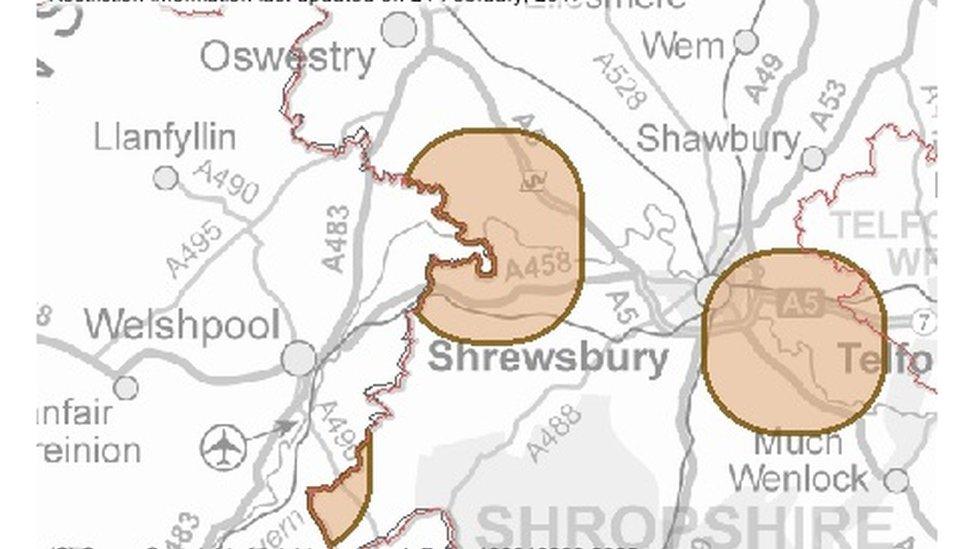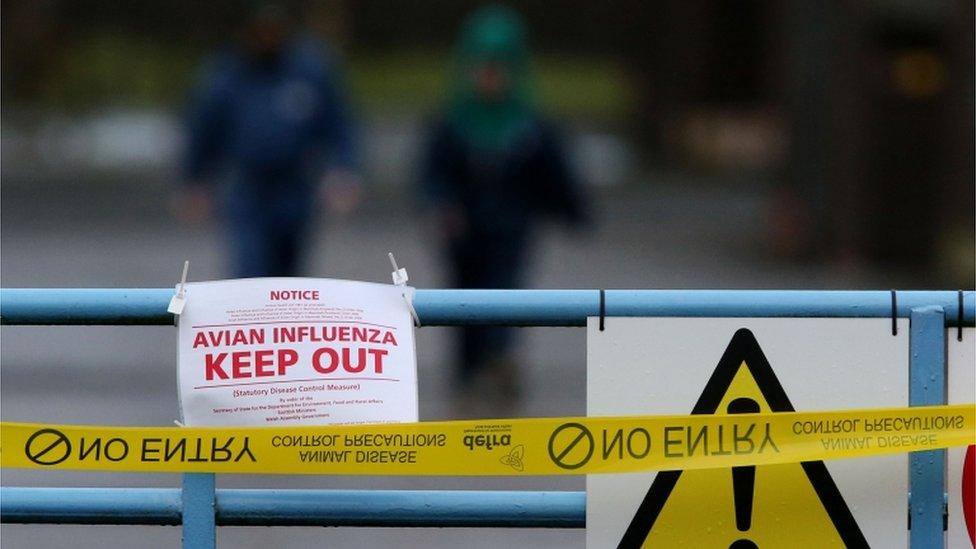Bird flu doesn't care about borders even if we do
- Published

Bridge over the Severn in Melverly. English chickens on this side must stay inside. One the other bank on the Welsh side they can be let out
New rules to tackle bird flu are coming into force this week. But radically different approaches on either side of the English Welsh border are causing confusion.
In England there is currently a blanket ban on letting all domestic birds outside.
This rule applies from the largest commercial poultry unit through to a small flock of hens in someone's back garden.
On the last day of February that will change and the government is introducing "High Risk Areas" (HRAs) for bird flu.
Inside these areas the rules will remain in force and birds must stay inside. Outside the HRA owners can chose to let their birds out if they take certain precautions.
High Risk Areas
This, external is a section from the government's map and you can see a typical HRA marked in red close to Telford.
Since bird flu is usually spread by migrating waterfowl an HRA is based around a body of water that could attract these birds. And so the government has created HRA's all over England. Big red, round, regular splodges.

Defra map showing bird flu High Risk Areas in Shropshire
But as you can also see west of Shrewsbury there's a very odd looking HRA. It's the usual circle but with a big chunk taken out of it.
That chunk is due to the border between England and Wales which actually follows the River Severn at that point. Ironically it's the River Severn and its ability to attract wild waterfowl, potentially infected with avian flu, that's the reason for the HRA on the English side in the first place. But the rules are very different in Wales.
Meeting in Melverly
I travelled to the Shropshire village of Melverly where farmers with chicken, geese or turkeys find themselves in an odd position.
On the bridge over the River Severn I met Andy Cawthray, external who breeds chickens on the English side of the border.
He can have up to 600 birds but because of the risk of avian flu he's currently keeping his flock at much lower numbers. It was Andy that noticed the problem with this particular HRA.
Andy explained to me that bird flu is a disease that's no respecter of country borders. If the science on the English side says it's not safe to let domestic poultry outside in this HRA, how can the same science on the Welsh side arrive at the opposite conclusion?
Free Range
One big problem caused by bird flu is it means free range flocks in HRA's have to stay locked inside and will lose their free range status. Owners will take a financial hit as free range eggs become barn eggs and they also don't like having to keep their birds quite literally cooped up.

science on the English side says it's not safe to let domestic poultry outside in an High Risk Area
But in the strange HRA on the border you could just rent a small bit of land on the Welsh side, move your hens and keep their free range status. All the while with your birds still as close as before to the water where the infected wild waterfowl might live.
All along the English Welsh border you find the same issue. There's a strange HRA rump a bit further south of Melverly and things get very confused in Gloucestershire as you get close to Chepstow. You can play around with the official DEFRA map here, external.
Both DEFRA in England and the Welsh Government, external make perfectly reasonable defences of their positions. On the Welsh side it's about putting the onus on farmers to do the right thing, the English approach is more prescriptive.
Both governments will re-examine things in April. Meanwhile with a nasty disease like bird flu, when the approach is devolved, perhaps the solution should be a bit more joined up?